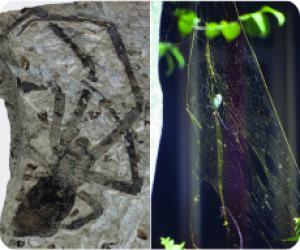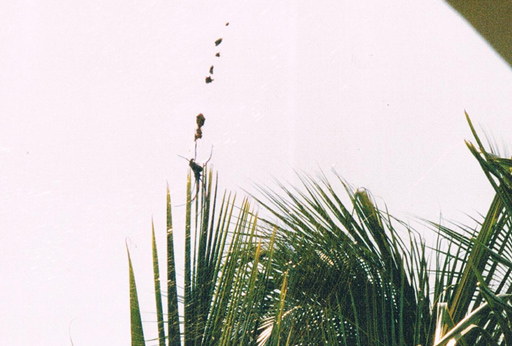Jurassic Park with Amazing Spider Webs
Jurassic Aged Fossil Proves some Orb Spiders are “Living Fossils”
China may be a hotbed for dinosaur and other vertebrate fossils, but the beautifully formed fossil of an invertebrate, a spider has grabbed the spotlight in the last few days. Spiders are members of the Arthropoda, invertebrates with eight legs and although they have been known since Carboniferous times, the fossil record for these creatures is extremely poor as their soft body parts do not normally get preserved. The spider fossil is exquisitely preserved.
With a leg span exceeding ten centimetres this new spider species was no tiny bug, if it produced large circular webs like its modern descendants it may have ensnared dragonflies and perhaps the occasional baby pterosaur. Scientists have proposed that this fossil is one of the largest arachnid specimens known from the fossil record. It has been named Nephila jurassica.
Nephila jurassica
A research team of Kansas University and Capital Normal University (Beijing, China) said the spider belongs to the living genus Nephila, or golden orb-weavers. An extremely long range for any animal genus, the Nephilids are example of what many people refer to as “living fossils”. Nephilids are the largest web-weaving spiders alive today (body length up to 5 cm, leg span 15 cm) and are common to the tropical and subtropical regions today.
This suggests that the palaeoclimate of Daohugou, China, where the specimen was found, was probably similarly warm and humid during the Jurassic. True, global temperatures in the Jurassic were much higher than today, so perhaps the warm, humid forests of this part of China teemed with life, including large spiders spinning their webs with the aim of catching an unwary flying creature.
The Fossil Spider (left) Compared to an Extant Orb-Weaver Spider (right)

Picture credit: University of Kansas Biodiversity Institute
In the image above, the figure on the left is of a fossil female golden orb-weaver spider (Nephila jurassica) from the Middle Jurassic of China. The body length about 1 inch, front legs about 2.5 inches (= leg span more than 5 inches). Next to it is an image of a living female golden orb-weaver spider (Nephila pilipes), in Queensland, Australia, on her golden orb web. It is about the same size as the fossil specimen.
Spider Fossil
Nephila spider females weave some of the largest orb webs known (up to 1.5 metres in diameter) with distinctive gold-coloured silk to catch a wide variety of medium-sized to large insects, but occasionally bats and birds as by-catches, so the possibility of a Jurassic Nephilid catching a small pterosaur, perhaps something like an Anurognathus, with a body length not much bigger than the fossil spider is intriguing. Typically, an orb-weaver spider first weaves a non-sticky spiral with space for sticky spirals in between.
Unlike most other orb-weaving spiders, Nephila do not remove the non-sticky spirals after weaving the sticky spirals. This results in a ‘manuscript paper’ effect when the orb is seen in the sunlight, because the sticky spirals reflect the light while the non-sticky spirals do not, thus resembling musical staves.
This fossil finding provides evidence that golden orb-webs were being woven and capturing medium to large insects in Jurassic times, and predation by these spiders would have played an important role in the natural selection of contemporaneous insects.
Orb spiders are common throughout the Old and New Worlds, whilst working in Kenya one of the Everything Dinosaur team members, took a photograph of a substantial spiders web that has been built outside their first floor hotel room. The picture below shows the orb spider and the macabre remains of some of the unfortunate insects that has blundered their way into this silken trap during the night.
An Impressive Orb Spider Web (Kenya)
Picture credit: Everything Dinosaur
The research was published in the online edition of Biology Letters. Paul A. Selden, Gulf-Hedberg Distinguished Professor at Kansas University and Director of the Palaeontological Institute, as well as ChungKun Shih and Dong Ren, professors from Capital Normal University, Beijing, produced the research paper.
Visit Everything Dinosaur’s website: Everything Dinosaur.


